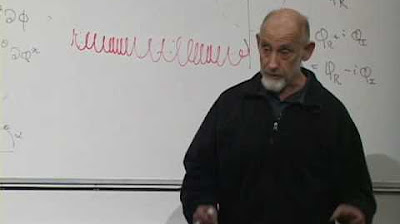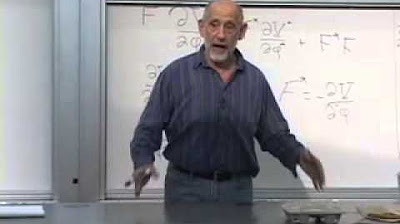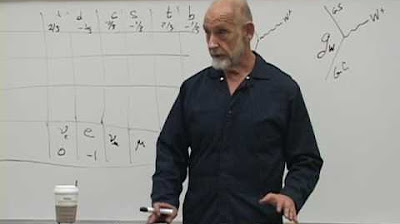Electroweak Theory and the Origin of the Fundamental Forces
TLDRThe video script delves into the complexity of the universe's fundamental forces and particles, exploring the concept of electroweak unification. It discusses the historical development of understanding weak interactions and electromagnetism, highlighting the role of gauge theories and symmetries in physics. The script introduces the idea of spontaneous symmetry breaking as a mechanism to explain the mass of weak force bosons, leading to the prediction of the Higgs field. It emphasizes the importance of symmetries and their breaking in shaping our understanding of particle physics and the standard model.
Takeaways
- 🌌 The universe's complexity hides a simpler, symmetric past where fundamental forces were unified under a single grand symmetry.
- 🔬 The weak interaction, responsible for certain types of radioactive decay like beta decay, was first identified as a distinct force due to its short range and charge-parity symmetry violation.
- 🤔 The quest to understand the unification of forces led to the discovery of the electromagnetic and weak forces being part of a single framework known as the electroweak unification.
- 🧠 The Higgs field and the mechanism of how particles gain mass are intrinsically linked to the understanding of electroweak unification.
- 🥼 Enrico Fermi's 'four fermion' model was an early attempt to describe beta decay but was limited to low energies and did not explain charge-parity symmetry violation.
- 🔋 Julian Schwinger's proposal of force-mediating gauge bosons for the weak interaction hinted at the electromagnetic force's involvement, despite the neutron and neutrino's participation.
- 🌐 Gauge theories, like quantum electrodynamics (QED), explain forces through symmetries in quantum equations of motion, resulting in force-carrying fields and particles.
- 📈 The requirement for W bosons to have mass due to the weak interaction's short range was theoretically challenging as gauge bosons should be massless under intact symmetries.
- 🔄 The concept of spontaneous symmetry breaking, where a system's ground state does not reflect the symmetry of its equations of motion, provides a mechanism for giving mass to gauge bosons.
- 🔄 The electroweak field, a combination of U(1) and SU(2) symmetries, is spontaneously broken at low temperatures, resulting in massless photons and massive weak force bosons.
- 🌠 The electroweak unification and the subsequent breaking of symmetries set the stage for a deeper quest to incorporate the strong nuclear force and unify all fundamental forces in the standard model.
Q & A
What is the main topic of the transcript?
-The main topic of the transcript is the unification of the electromagnetic and weak forces, known as electroweak unification, and how it leads to an understanding of the Higgs field and how particles gain mass.
What are the fundamental forces mentioned in the transcript?
-The fundamental forces mentioned in the transcript are the electromagnetic and weak forces, which are part of the four fundamental forces in nature.
What is the significance of the weak interaction in the context of the transcript?
-The weak interaction is significant because it is responsible for some types of radioactive decay, such as beta decay, and it was the first force to be identified in this manner. It is also a key component in the electroweak unification theory.
What is the role of the Higgs field in the context of particle mass?
-The Higgs field plays a crucial role in giving particles mass. It is involved in the process of spontaneous symmetry breaking, which leads to the massive weak force bosons that are observed in nature.
What is the difference between fermions and bosons?
-Fermions are the particles that make up matter and follow the Pauli exclusion principle, while bosons are force-mediating particles that can be in the same state as many other bosons, such as the photon, which is responsible for electromagnetism.
What is the significance of the U(1) symmetry in quantum mechanics?
-The U(1) symmetry is significant in quantum mechanics because it is the symmetry that leads to the existence of the electromagnetic field and its associated particle, the photon. It is a gauge theory that arises from the invariance of the Schrodinger equation to changes in the local phase of the wavefunction.
How does the SU(2) symmetry contribute to the weak interaction?
-The SU(2) symmetry contributes to the weak interaction by providing three degrees of freedom after accounting for unitarity, which are used to introduce a new field with three bosons that are responsible for mediating the weak force.
What is spontaneous symmetry breaking?
-Spontaneous symmetry breaking is a phenomenon where the equations of motion of a system have a particular symmetry, but the state of the system does not reflect that symmetry. This can lead to particles acquiring mass, as in the case of the weak force bosons.
What is the electroweak field, and what are its characteristics?
-The electroweak field is a combination of the U(1) and SU(2) symmetries, which at high temperatures (above 10^15 Kelvin) is symmetric and gives rise to four massless bosons. At lower temperatures, this symmetry is spontaneously broken, resulting in a massless photon and three massive weak force bosons.
How does the electroweak unification relate to the quest for a grand unified theory?
-The electroweak unification sets the stage for the search for a grand unified theory by showing that deeper symmetries can unite different forces. It leads to the inclusion of the strong nuclear force in the quest to unify all fundamental forces into a single framework, known as the standard model.
What is the role of the Higgs field in the electroweak unification?
-The Higgs field plays a critical role in the electroweak unification by being responsible for the spontaneous symmetry breaking that gives mass to the weak force bosons, while leaving the photon massless. This process is essential for the successful description of the electroweak force.
Outlines
🌌 The Quest for Electroweak Unification
This paragraph delves into the complexity of our universe, highlighting the variety of elementary particles and the fundamental forces that govern them. It introduces the concept that these forces were once unified under a single grand symmetry, and explores the question of how one force can separate into multiple. The focus then shifts to the electromagnetic and weak forces, discussing their historical understanding and the journey towards electroweak unification. The paragraph sets the stage for an exploration of the Higgs field and the mechanism by which particles acquire mass.
🤔 The Mysterious Weak Interaction
The second paragraph provides an in-depth look at the weak interaction, a force responsible for certain types of radioactive decay. It discusses the historical discovery of the beta decay and the initial attempts by Enrico Fermi to describe it within the framework of quantum mechanics. The paragraph also touches on the challenges faced by early models of the weak interaction, such as the violation of charge-parity symmetry and the introduction of massive gauge bosons, which was a theoretical quandary since gauge bosons should be massless to maintain the symmetries of gauge theory.
📐 Gauge Theory and Symmetry
This paragraph explains the concept of gauge theory and its reliance on symmetries in the quantum equations of motion. It uses the example of quantum electrodynamics (QED) to illustrate how the electromagnetic force arises from the symmetry of the Schrodinger equation. The paragraph further discusses the role of gauge bosons and the importance of the U(1) symmetry in the creation of the photon. It then introduces the SU(2) symmetry and its implications for the weak force, hinting at the unification of the weak and electromagnetic forces through the electroweak theory.
🔥 Spontaneous Symmetry Breaking and the Higgs Field
The fourth paragraph discusses the phenomenon of spontaneous symmetry breaking, using the analogy of a magnetic material to explain how a system can transition from a symmetric state to one that breaks this symmetry. It then applies this concept to the weak force, suggesting that the equations of motion may respect certain symmetries while the physical system itself does not. The paragraph sets up the stage for the introduction of the Higgs field, which is responsible for giving mass to the weak force bosons through this mechanism of spontaneous symmetry breaking, and hints at the broader implications of the electroweak unification for understanding the fundamental forces of the universe.
Mindmap
Keywords
💡Elementary Particles
💡Fundamental Forces
💡Electroweak Unification
💡Higgs Field
💡Quantum Electrodynamics (QED)
💡Gauge Theory
💡Spontaneous Symmetry Breaking
💡Weak Interaction
💡Charge-Parity Symmetry
💡Energy-Time Uncertainty Relation
💡Unitary Group
💡SU(2) Symmetry
Highlights
The universe's complexity arises from a simpler, more symmetric state.
The forces of nature were once unified under a single grand symmetry.
Electromagnetic and weak forces were once a single entity.
The weak force's discovery is tied to beta decay, involving a neutron turning into a proton, electron, and neutrino.
Enrico Fermi's 'four fermion' interaction was an early attempt to describe beta decay quantumly.
Quantum Electrodynamics (QED) successfully explains electromagnetism through force-mediating particles like the photon.
Julian Schwinger proposed force-mediating gauge bosons for the weak interaction in 1957.
The weak interaction's ability to change a neutral particle into a charged pair hints at a connection with electromagnetism.
The existence of 'weak bosons' with mass was indicated by the short range nature of the weak interaction.
Gauge theories, like QED, arise from the symmetries of quantum equations of motion.
The concept of gauge theory is rooted in the insistence on symmetry in the Schrodinger equation.
The Unitary group U(1) is fundamental to understanding electromagnetism through gauge theory.
The SU(2) symmetry contributes additional degrees of freedom beyond U(1), essential for a gauge theory of the weak field.
The masslessness of gauge bosons is a consequence of the perfect symmetries from which they originate.
Spontaneous symmetry breaking allows for the existence of massive force carriers despite the symmetries of the equations of motion.
The electroweak field combines U(1) and SU(2) symmetries, leading to the unification of electromagnetism and the weak force.
At high temperatures, the electroweak symmetry is intact, but at lower temperatures, it is spontaneously broken, giving mass to the weak force bosons.
The Higgs field plays a crucial role in the electroweak unification and the mass of particles.
The quest for deeper symmetries has led to the standard model, encompassing U(1)xSU(2)xSU(3).
The broken symmetries of spacetime result in the rich variety of particles and their complex interactions.
Transcripts
Browse More Related Video
5.0 / 5 (0 votes)
Thanks for rating:





